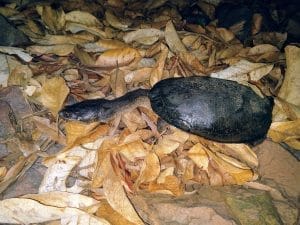Chelodina pritchardi (Pritchard’s Snake-necked Turtle)
Home > Turtle Database > Chelodina pritchardi (Pritchard’s Snake-necked Turtle)

Chelodina pritchardi is a unique species of turtle known for its distinctive long neck and captivating appearance. Found primarily in New Guinea, this species is a fascinating example of the diverse and specialized turtles within the family Chelidae.
Native To These Regions
Papua New GuineaNative Turtle Species Map – Find Turtles by Region
Scientific Classification
- Kingdom: Animalia
- Phylum: Chordata
- Class: Reptilia
- Order: Testudines
- Family: Chelidae
- Genus: Chelodina
- Species: Chelodina pritchardi
Common Names
- Pritchard’s Snake-necked Turtle
This Hilarious Turtle Book Might Know Your Pet Better Than You Do
Let’s be real—most turtle care guides feel like reading a textbook written by a sleep-deprived zookeeper.
This one’s not that.
Told from the snarky point of view of a grumpy, judgmental turtle, 21 Turtle Truths You’ll Never Read in a Care Guide is packed with sarcasm, sass, and surprisingly useful insights.
And hey—you don’t have to commit to the whole thing just yet.
Grab 2 free truths from the ebook and get a taste of what your turtle really thinks about your setup, your food choices, and that weird plastic palm tree.
It’s funny, it’s honest, and if you’ve ever owned a turtle who glares at you like you’re the problem—you’ll feel seen.
Identification
Description
Chelodina pritchardi is characterized by its elongated neck, which is nearly as long as its carapace, giving it a snake-like appearance. The carapace is typically oval-shaped and ranges from brown to dark olive in color, while the plastron is lighter, often yellowish. The limbs are robust, with webbed toes adapted for swimming.
Sexual Dimorphism
Males are generally smaller than females, with longer tails. Females have a broader and more rounded carapace, while males tend to have a concave plastron, which aids in mating.
Check more turtles from the Chelodina genus
Native Origin and Distribution
Geographical Range
Chelodina pritchardi is native to New Guinea, particularly found in the lowland rivers and swamps of the southern and western regions of the island.
Preferred Habitat
This species prefers slow-moving rivers, swamps, and wetlands with abundant vegetation. They are highly aquatic and are rarely seen on land, except during nesting.
Behavior
Feeding Habits
Chelodina pritchardi is carnivorous, feeding primarily on small fish, amphibians, and invertebrates. They use their long necks to strike quickly at prey, which is an adaptation to their aquatic environment.
Predators
Natural predators include larger reptiles, birds of prey, and some mammals. Eggs and juveniles are particularly vulnerable to predation.
Reproduction
Breeding Season
The breeding season typically occurs during the wet season when water levels are high, providing ideal conditions for nesting and hatchling survival.
Reproductive Method
Females lay a clutch of eggs on land, usually in sandy or soft soil near water sources. The eggs incubate for several months before hatching.
Conservation
Extinction Status
Chelodina pritchardi is currently listed as Vulnerable on the IUCN Red List due to habitat destruction and illegal collection for the pet trade.
Threats
The primary threats include habitat loss due to agricultural expansion and water pollution, as well as over-collection for the pet trade.
Conservation Measures
Conservation efforts include habitat protection, regulation of trade, and breeding programs in captivity to help maintain population numbers.
Economic Importance
Chelodina pritchardi has some economic importance in the pet trade, where it is sought after due to its unique appearance. However, this demand has also contributed to its threatened status.
Interesting Facts
- Chelodina pritchardi is named after John Pritchard, a well-known herpetologist who contributed significantly to the study of this species.
- The species’ long neck allows it to catch prey with lightning speed, making it an efficient predator in its aquatic environment.
- Unlike many other turtles, Chelodina pritchardi rarely basks out of water, preferring to remain submerged for extended periods.

About Author
Muntaseer Rahman started keeping pet turtles back in 2013. He also owns the largest Turtle & Tortoise Facebook community in Bangladesh. These days he is mostly active on Facebook.














